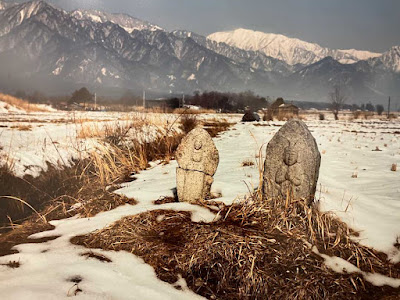After handing over the ¥300 entrance fee, I instantly understand why those essays are collected under the title of “Ki-iroi tento”(The yellow tent). For standing opposite the door is the namesake tent itself, as personally designed by Tabuchi for bivvies while stalking high-altitude sunrises. So the photographer and writer was also a pioneer of lightweight camping gear.
Speaking of the sunrises, I’m surprised at first not to see any of Tabuchi’s trademark high-contrast black-and-white mountain photography on the walls. As the repository for the photographer’s entire archive, the museum regularly rotates the photos it shows, and today’s exhibition focuses less on the mountains than on the scenery of Azumino during the 1960s.
On second thoughts, nothing could be more appropriate. You could say that Azumino was the making of Tabuchi. After his house in Tokyo was requisitioned during the air raids of 1945, he moved to the mountain-fringed altiplano north of Matsumoto.
At the age of 40, this was a new start. Soon his photos started appearing in magazines and he published his first photo collection at the age of 46 – a natural progression from the photo scrapbooks he’d been in the habit of assembling. Then he went professional as a photographer and writer.
When Japan started on its high-growth period in the 1960s, Tabuchi saw all too clearly what would happen to Azumino. As its familiar rural scenes started to vanish under the pall of ribbon development, his photographs became their threnody. Even the faded mid-Showa hues of the colour prints glow with nostalgia for a lost world.
Yet another strand runs through Tabuchi’s photography. Like many children, he was fascinated by butterflies. Unlike most, he developed a formidable talent for drawing and painting them: the museum has some 470 sketches and paintings in its collection.
And, as his skills with a camera evolved, he started photographing the insects too. Touchingly, his magisterial book on the alpine butterflies of Japan is dedicated to his wife.
Ah yes, the cameras: a glass-fronted cabinet deploys a complete armoury. The Rittrecks, Koniflexes, Asahiflexes and Mamiyas look less than user-friendly by today's standards. I shake my head, astonished at the virtuosity of Tabuchi’s close-up images of flowers and insects; even with the latest technology, few can aspire to making pictures like these …
But I do aspire to making the next train, having promised the Sensei to be back for a late supper. Alas, there will be no time to investigate Tabuchi's collaboration with the folklorist Mukaiyama Masashige on yukigata, the patterns left on mountainsides by the melting snow. And the reading room full of reference works below the exhibition hall will also have to await another visit; even an extra hour of browsing here won't do full justice to the manifold talents of Azumino’s uomo universale.
Retrieving my weatherbeaten pack from the Memorial Museum's friendly staff and adding a souvenir photo book as well as a biography to its weight, I step out into the grey afternoon and start walking towards the station. Ariake-yama, the hundred-and-first of the Hundred Mountains, looms ahead.
And there, rising above the intervening ridges is Jōnen-dake, the mountain that Tabuchi is said to have climbed two hundred and six times, a yellow tent in his pack, in search of the natural world.













No comments:
Post a Comment